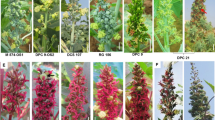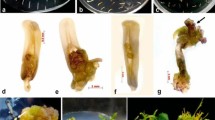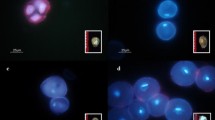Abstract
This study explores and reports on the gain brought to the morphogenetic aptitude of female date palm inflorescences through in vitro hermaphrodism induction. It investigates the main factors involved in the process of sex modification through hormonal induction, such as the floral developmental stage and hormone combination and concentration. It demonstrates that the vestigial stamens (staminodes) of female date palm flowers display a new and high capacity to proliferate under particular in vitro conditions, without blocking carpel’s development, leading to morphologically typical hermaphrodite flowers. This de novo activation of repressed stamens was found to occur rapidly. The isolated pollen mother cells appear in the obtained anther’s locules and undergo an ordinary microsporogenesis process. The data show that hermaphrodism induction depended heavily on both the growth regulators applied and the flower’s developmental stage. They also confirm the early theory that suggests that dioecious plants come from a hermaphrodite ancestor. Such hermaphrodism control can provide new prospects and opportunities for the investigation of the in vitro self-fertilization process. It can also be useful in improving the understanding of the genetic mechanism involved in sex organ development in date palm.





Similar content being viewed by others
Abbreviations
- IBA:
-
Indole-3-butyric acid
- BAP:
-
6-Benzylaminopurine
- 2,4-D:
-
2,4-Dichlorophenoxyacetic acid
- MS:
-
Murashige and Skoog
References
Ainsworth C (2000) Boys and girls come out to play: the molecular biology of dioecious plants. Ann Bot 86:211–221
Bhaskaran S, Smith R (1992) Somatic embryogenesis from shoot tip and immature inflorescence of Phoenix dactylifera cv. Barhee. Plant Cell Rep 12:22–25
Calderon-Urrea A, Dellaporta SL (1999) Cell death and cell protection genes determine the fate of pistils in maize. Development 126:435–441
Caporali E, Carboni A, Galli MG, Rossi G, Spada A, Marziani Longo GP (1994) Development of male and female flower in Asparagus officinalis. Search for point of transition from hermaphroditic to unisexual developmental pathway. Sex Plant Reprod 7(4):239–249
Chaibi N, Ben Abdallah A, Harzallah H, Lepoivre P (2002) Potentialités androgénétiques du palmier dattier Phoenix dactylifera L. et culture in vitro d’anthères. Biotechnol Agron Soc Environ 6(4):201–207
Charlesworth D (2002) Plant sex determination and sex chromosomes. Heredity 88:94–101
Charlesworth D (2004) Plant Evolution: modern sex chromosomes. Curr Biol 14:R271–R273
Charlesworth D, Charlesworth B, Marais G (2005) Steps in the evolution of heteromorphic sex chromosomes. Heredity 95:118–128
Chhibber N, Sharma N, Verma S (2007) Genetic system of chillies I. Breeding and meiotic system of Var. KL-1. Cytologia 72(1):17–21
Cordero RE, Gunckel JE (1982) The effects of acute and chronic gamma irradiation on Lupinus albus L.-II. Effects of acute irradiation on floral development. Environ Exp Bot 22:127–137
Corley RHV (1976) Sex differentiation in oil palm: effects of growth regulators. J Exp Bot 27:553–558
Costa JY, Forni-Martins ER (2004) A triploid cytotype of Echinodorus tennellus. Aquat Bot 79:325–332
Darwin C (1877) The different forms of flowers on plants of the same species. Murray, London
Dellaporta SL, Calderon-Urrea A (1994) The sex determination process in maize. Science 266(5190):1501–1505
De Mason DA, Tisserat B (1980) The occurrence and structure of apparently bisexual flowers in the date palm, Phoenix dactylifera L. (Arecaceae). Bot J Linn Soc 81:283–292
De Mason DA, Stolte KW, Tisserat B (1982) Floral development in Phoenix dactylifera. Can J Bot 60(8):1437–1446
Drira N, Benbadis A (1985) Multiplication végétative du palmier dattier (Phoenix dactylifera L.) par réversion, en culture in vitro, d’ébauches florales de pieds femelles adultes. J Plant Physiol 119:227–235
Fki L, Masmoudi R, Drira N, Rival A (2003) An optimised protocol for plant regeneration from embryogenic suspension cultures of date palm (Phoenix dactylifera L.) cv. Deglet Nour. Plant Cell Rep 21:517–524. doi:10.1007/s00299-002-0558-5
Guttman DS, Charlesworth D (1998) An X-linked gene with a degenerate Y-linked homologue in a dioecious plant. Nature 393:263–266
Halle F, Oldeman RAA, Tomlinson PB (1978) Tropical trees and forests: an architectural analysis. Springer, Berlin
Hao YJ, Wang DH, Peng YB, Bai SL, Xu LY, Li YQ, Xu ZH, Bai SN (2003) DNA damage in the early primordial anther is closely correlated with stamen arrest in the female flower of cucumber (Cucumis sativus L.). Planta 217:888–895
Kater MM, Franken J, Carney KJ, Colombo L, Angenent GC (2001) Sex determination in the monoecious species cucumber is confined to specific floral whorls. Plant Cell 13:481–493
Komai F, Masuda K (2004) Plasticity in sex expression of spinach (Spinacia oleracea) regenerated from root tissues. Plant Cell Tissue Organ Cult 78(3):285–287
Komai F, Shikazono N, Tanaka A (2003) Sexual modification of female spinach seeds (Spinacia oleracea L.) by irradiation with ion particles. Plant Cell Rep 21:713–717
Law TF, Lebel-Hardenack S, Grant SR (2002) Silver enhances stamen development in female white campion (Silene latifolia [Caryophyllaceae]). Am J Bot 89(6):1014–1020
Lebel-Hardenack S, Grant SR (1997) Genetics of sex determination in flowering Plants. Trends Plant Sci 2:130–136
Liu Z, Moore PH, Ma H, Ackerman CM, Ragiba M, Yu Q, Pearl HM, Kim MS, Charlton JW, Stiles JI, Zee FT, Paterson AH, Ming R (2004) A primitive Y chromosome in papaya marks incipient sex chromosome evolution. Nature 427:348–352
Madan L, Jaiswal VS (1988) Modification of flower sex and acid phosphatase activity by phthalimides in female plants of Morus nigra L. Plant Growth Regul 7(1):29–37
Marutani M, Sheffer RD, Kameto H (1993) Cytological analysis of Arithurium andraenum (Araceae), its related taxa and their hybrids. Am J Bot 80:93–103
Ming R, Moore PH (2007) Genomics of sex chromosomes. Curr Opin Plant Biol 10:123–130
Monéger F, Negrutiu I (2000) Du sexe des fleurs. Biofutur 202:32–35
Murashige T, Skoog F (1962) A revised medium for rapid growth and bio assays with tobacco tissue cultures. Physiol Plant 15:473–497
Negrutiu I, Vyskot B, Barbacar N, Georgiev S, Moneger F (2001) Dioecious plants: a key to the early events of sex chromosome evolution. Plant Physiol 127:1418–1424
Parker JS, Clark MS (1991) Dosage sex-chromosome systems in plants. Plant Sci 80:79–92
Renner SS, Ricklefs RE (1995) Dioecy and its correlates in the flowering plants. Am J Bot 82:596–606
Rigamoto RR, Tyagi AP (2002) Pollen fertility status in coastal plant species of Rotuma Island. South Pac J Nat Sci 20:30–33
Siljak-Yakovlev S, Cerbah M, Sarr A, Benmalek S, Bounaga N, Coba de la Pena T, Brown S (1996) Chromosomal sex determination and heterochromatin structure in date palm. Sex Plant Reprod 9:127–132
Singh BB, Adu-Dapaah HK (1998) A partial male sterile mutant in cowpea. Afr Crop Sci J 6(1):97–101
Singh RP, Gunckel JE (1965) Studies on the effect of chronic gamma rays on Ricinus - I Development of pollen, ovule and female gametophyte. Radiat Bot 5(6):525–542
Tanurdzic M, Banks JA (2004) Sex determining mechanisms in land plants. Plant Cell 16:61–71
Tomlinson PB (1961) Anatomy of the monocotyledons. II. Palmae. Clarendon Press, Oxford, 453 pp
Truernit E, Stadler R, Baier K, Sauer N (1999) A male gametophyte-specific monosaccharide transporter in Arabidopsis. Plant J 17(2):191–201
Vyskot B, Hobza R (2004) Gender in plants: sex chromosomes are emerging from the fog. Trends Genet 20(9):432–438
Welgel D, Meyerowltz EM (1994) The ABCs of floral homeotic genes. Cell 78:203–209
Zluvova J, Georgiev S, Janousek B, Charlesworth D, Vyskot B, Negrutiu I (2007) Early events in the evolution of the Silene latifolia Y chromosome: male specialization and recombination arrest. Genetics 177:375–386. doi:10.1534/genetics.107.071175
Acknowledgments
This work was supported by the Ministry of Higher Education, Scientific Research and Technology in Tunisia and the International Atomic Energy Agency, under TC Project RAF/5/049. The authors would like to thank the staff of the Regional Centre of Oasian Agriculture Research in Deguache (south of Tunisia) for their help in collecting the inflorescences. They wish also to extend their gratitude to Mr. Anouar Smaoui from the English Department at the Sfax Faculty of Science for his valuable editing and careful reviewing of the manuscript of the current study.
Author information
Authors and Affiliations
Corresponding author
Additional information
Communicated by K. Kamo.
Rights and permissions
About this article
Cite this article
Masmoudi-Allouche, F., Châari-Rkhis, A., Kriaâ, W. et al. In vitro hermaphrodism induction in date palm female flower. Plant Cell Rep 28, 1–10 (2009). https://doi.org/10.1007/s00299-008-0611-0
Received:
Revised:
Accepted:
Published:
Issue Date:
DOI: https://doi.org/10.1007/s00299-008-0611-0




